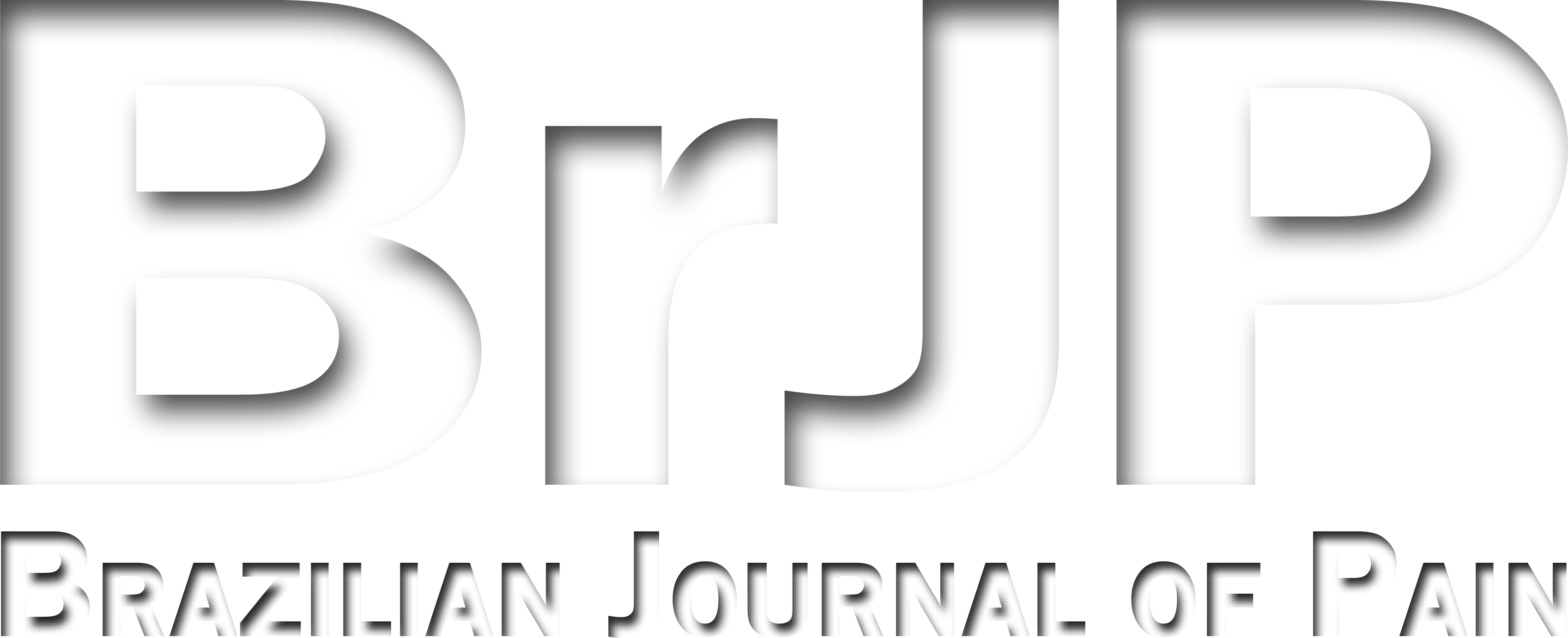Correlations between masticatory muscle activity, quality of life, and dysfunction severity in women with chronic temporomandibular disorder
Relação entre atividade elétrica mastigatória, qualidade de vida e gravidade da disfunção em mulheres com disfunção temporomandibular crônica
Carlos Eduardo Fassicollo; Barbara Camila Flissak Graefling; Lilian Gerdi Kittel Ries
Abstract
Keywords
Resumo
Palavras-chave
Referências
Dworkin SF, Massoth DL. Temporomandibular disorders and chronic pain: disease or illness?. J Prosthet Dent. 1994;72(1):29-38.
Schiffman E, Ohrbach R, Truelove E, Look J, Anderson G, Goulet JP. Diagnostic Criteria for Temporomandibular Disorders (DC/TMD) for Clinical and Research Applications: recommendations of the International RDC/TMD Consortium Network* and Orofacial Pain Special Interest Groupdagger. J Oral Facial Pain Headache. 2014;28(1):6-27.
Peck CC, Murray GM, Gerzina TM. How does pain affect jaw muscle activity: The Integrated Pain Adaptation Model. Aust Dent J. 2008;53(3):201-7.
Ferrario VF, Tartaglia GM, Luraghi FE, Sforza C. The use of surface electromyography as a tool in differentiating temporomandibular disorders from neck disorders. Man Ther. 2007;12(4):372-9.
Lauriti L, Motta LJ, de Godoy CH, Biasotto-Gonzalez DA, Politti F, Mesquita-Ferrari RA. Influence of temporomandibular disorder on temporal and masseter muscles and occlusal contacts in adolescents: an electromyographic study. BMC Musculoskelet Disord. 2014;15:123.
Fassicollo CE, Machado BCZ, Garcia DM, de Felicio CM. Swallowing changes related to chronic temporomandibular disorders. Clin Oral Investig. 2019;23(8):3287-96.
Ries LG, Alves MC, Bérzin F. Asymmetric activation of temporalis, masseter, and sternocleidomastoid muscles in temporomandibular disorder patients. Cranio. 2008;26(1):59-64.
Ries LG, Graciosa MD, Medeiros DL, Pacheco SC, Fassicolo CE, Graefling BC. Influence of craniomandibular and cervical pain on the activity of masticatory muscles in individuals with Temporomandibular Disorder. Codas. 2014;26(5):389-94.
Pitta NC, Nitsch GS, Machado MB, de Oliveira AS. Activation time analysis and electromyographic fatigue in patients with temporomandibular disorders during clenching. J Electromyogr Kinesiol. 2015;25(4):653-7.
Ferreira CL, Machado BC, Borges CG, Rodrigues Da Silva MA, Sforza C. Impaired orofacial motor functions on chronic temporomandibular disorders. J Electromyogr Kinesiol. 2014;24(4):565-71.
Strini PJ, Strini PJ, Barbosa Tde S, Gaviao MB. Assessment of thickness and function of masticatory and cervical muscles in adults with and without temporomandibular disorders. Arch Oral Biol. 2013;58(9):1100-8.
Boderé C, Téa SH, Giroux-Metges MA, Woda A. Activity of masticatory muscles in subjects with different orofacial pain conditions. Pain. 2005;116(1-2):33-41.
De Felicio CM, Ferreira CL, Medeiros AP, Rodrigues Da Silva MA, Tartaglia GM. Electromyographic indices, orofacial myofunctional status and temporomandibular disorders severity: a correlation study. J Electromyogr Kinesiol. 2012;22(2):266-72.
Ohrbach R, Bair E, Fillingim RB, Gonzalez Y, Gordon SM, Lim PF. Clinical orofacial characteristics associated with risk of first-onset TMD: the OPPERA prospective cohort study. J Pain. 2013;14(12 Suppl):T33-50.
Fillingim RB, Ohrbach R, Greenspan JD, Knott C, Diatchenko L, Dubner R. Psychological factors associated with development of TMD: the OPPERA prospective cohort study. J Pain. 2013;14(12 Suppl):T75-90.
Blanco-Aguilera A, Blanco-Aguilera E, Serrano-Del-Rosal R, Biedma-Velázquez L, Rodriguez-Torronteras A, Segura-Saint-Gerons R. Influence of clinical and psychological variables upon the oral health-related quality of life in patients with temporomandibular disorders. Med Oral Patol Oral Cir Bucal. 2017;22(6):e669-78.
de Godoy CH, Silva PF, de Araujo DS, Motta LJ, Biasotto-Gonzalez DA, Politti F. Evaluation of effect of low-level laser therapy on adolescents with temporomandibular disorder: study protocol for a randomized controlled trial. Trials. 2013;14:229.
Ciconelli RM, Ferraz MB, Santos W, Meinao I, Quaresma MR. Brazilian-Portuguese version of the SF-36: A reliable and valid quality of life outcome measure. Rev Bras Reumatol. 1999;39(3):143-50.
de Felicio CM, Melchior Mde O, Da Silva MA. Clinical validity of the protocol for multi-professional centers for the determination of signs and symptoms of temporomandibular disorders: Part II. Cranio. 2009;27(1):62-7.
Hermens HJ, Freriks B, Disselhorst-Klug C, Rau G. Development of recommendations for SEMG sensors and sensor placement procedures. J Electromyogr Kinesiol. 2000;10(5):361-74.
Ferrario VF, Sforza C, Colombo A, Ciusa V. An electromyographic investigation of masticatory muscles symmetry in normo-occlusion subjects. J Oral Rehabil. 2000;27(1):33-40.
Ferrario VF, Tartaglia GM, Galletta A, Grassi GP, Sforza C. The influence of occlusion on jaw and neck muscle activity: a surface EMG study in healthy young adults. J Oral Rehabil. 2006;33(5):341-8.
Pestana G. Data Analysis for Social Sciences - Complementarity of SPSS. 2000:269-461.
Cohen J. Statistical power analysis for the behavioral sciences. New York. 1988;2:567.
Hodges PW, Smeets RJ. Interaction between pain, movement, and physical activity: short-term benefits, long-term consequences, and targets for treatment. Clin J Pain. 2015;31(2):97-107.
Shedden Mora M, Weber D, Borkowski S, Rief W. Nocturnal masseter muscle activity is related to symptoms and somatization in temporomandibular disorders. J Psychosom Res. 2012;73(4):307-12.
Mense S. Nociception from skeletal muscle in relation to clinical muscle pain. Pain. 1993;54(3):241-89.
Ries LG, Graciosa MD, Soares LP, Sperandio FF, Santos GM, Degan VV. Effect of time of contraction and rest on the masseter and anterior temporal muscles activity in subjects with temporomandibular disorder. Codas. 2016;28(2):155-62.
Xu L, Fan S, Cai B, Fang Z, Jiang X. Influence of sustained submaximal clenching fatigue test on electromyographic activity and maximum voluntary bite forces in healthy subjects and patients with temporomandibular disorders. J Oral Rehabil. 2017;44(5):340-6.
Santana-Mora U, Martinez-Insua A, Santana-Penin U, del Palomar AP, Banzo JC, Mora MJ. Muscular activity during isometric incisal biting. J Biomech. 2014;47(16):3891-7.
Submetido em:
18/04/2019
Aceito em:
05/08/2019


